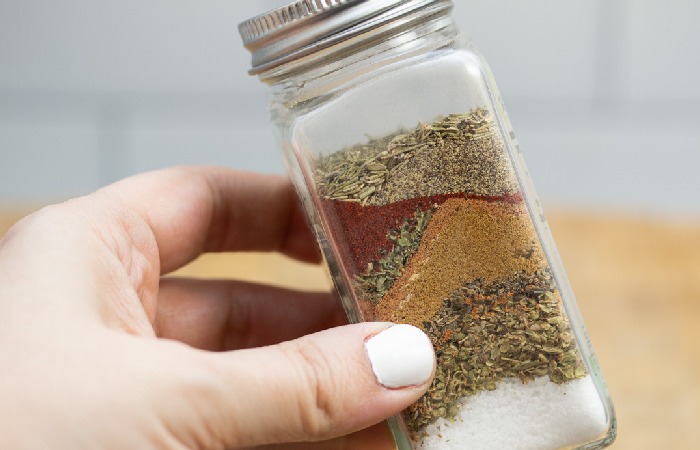Fajita seasoning is a blend of spices and herbs used to season fajitas, a popular Tex-Mex dish typically made with grilled or sautéed meat (such as beef, chicken, or shrimp) and vegetables. By making your own fajita seasoning at home, you can fully control the ingredients and customize the flavor to suit your taste preferences. This article will explore the benefits of homemade fajita seasoning, provide a popular recipe, discuss the differences between fajita seasoning and taco seasoning, and offer storage and usage tips. Let’s dive in!
The seasoning mix enhances the dish’s flavor and adds a characteristic Tex-Mex taste.

While specific recipes may vary, typical ingredients found in it include:
- Chili powder: Provides a spicy and smoky flavor.
- Cumin: Adds a warm and earthy taste.
- Paprika: Imparts a slightly sweet and smoky flavor.
- Garlic powder: Enhances the savory notes.
- Onion powder: Adds a mild and sweet onion taste.
- Oregano: Contributes a subtle herbal flavor.
- Salt and pepper: Used to season and balance the overall taste.
These ingredients are combined in varying ratios to create a versatile seasoning blend suitable for fajitas. Some commercial brands may include additional ingredients like red pepper flakes, sugar, or other spices to customize the flavor profile. It can be purchased pre-made or prepared at home by mixing spices according to personal preference.
Making your own at home allows you to fully control the ingredients and customize the flavor to suit your taste preferences. This article will explore the benefits of homemade fajita seasoning, provide a popular recipe, discuss the differences between it and taco seasoning, and offer storage and usage tips. Let’s dive in!
Table of Contents
What is in Fajita Seasoning?
It typically consists of Mexican spices like cumin and chili powder, complemented by additional ingredients such as onion powder, paprika, garlic powder, and cayenne pepper. The combination creates a well-balanced blend of flavors that enhance the taste of fajitas. Our featured recipe includes cornstarch, which helps thicken the seasoning when cooked with meat and vegetables.
Fajita Seasoning vs. Taco Seasoning

While fajita and taco seasoning share similar ingredients, they differ. Taco seasoning tends to have more oregano and chili powder than fajita seasoning. However, both can be used interchangeably in recipes, albeit with slight variations in flavor.
How Much is Fajita Seasoning in a Packet?
If your recipe calls for a packet of it, replace it with approximately three tablespoons of homemade seasoning. It’s important to note that commercial brands may have slightly different packaging sizes, but a standard packet usually contains around 1 ounce or three tablespoons of seasoning.
Benefits of Using Homemade Fajita Seasoning

a. Full control over ingredient
Making your fajita seasoning allows you to customize the blend to suit your preferences. You can adjust the spiciness, sweetness, or other flavors according to your taste.
b. Cost-effective
Creating your spice blend is generally more affordable than buying pre-made seasoning packets. Once you have the necessary spices in your pantry, you can make multiple batches without breaking the bank.
c. Fresher and healthier
Homemade seasoning ensures that you are using fresh, high-quality spices without any additives or preservatives that may be present in store-bought options.
How to Store Fajita Seasoning
To maintain the freshness and potency of your homemade, store it in an airtight container in a dry and cool place like your spice cabinet or pantry. The seasoning can stay fresh for up to six months when stored properly.
Usage Ideas for Fajita Seasoning
Besides the classic chicken, beef, or shrimp fajitas, there are various creative ways to incorporate it into your dishes.
Here are a few ideas:
Vegetable fajitas
Season and grill a medley of colorful vegetables for a delicious vegetarian option.
Shrimp fajitas
- Sauté shrimp with it and serve in tortillas with your favorite toppings.
- Fajita-inspired pizzas melt or quesadillas:
- Use the seasoning to add a Tex-Mex twist to these dishes.
- Experiment with other proteins: Use the seasoning blend on tofu, fish, or grilled halloumi cheese for unique flavor combinations.
Conclusion
Creating your fajita seasoning opens up a world of possibilities regarding flavor customization and culinary creativity. Following the simple recipe provided and keeping the storage and usage tips in mind, you can enjoy homemade that will elevate your dishes to new heights. Say goodbye to store-bought packets and embrace the flavorful adventure of making your own at home.

